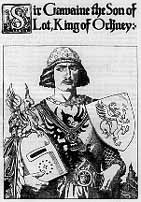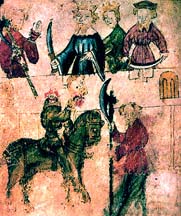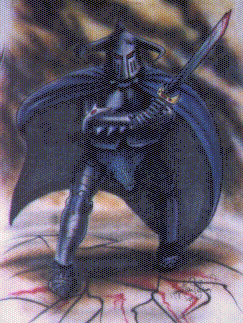

 Sir
Gawain and the Green Knight
Sir
Gawain and the Green KnightA summary of a short passage in the text
Sir Gawain and the Green Knight was written by an anonymous author in the 14th century. It was written in a dialect from Northern England. The poem uses alliteration similar to the Anglo-Saxon form of poetry. Alliteration uses a repetition of consonants. The poem ends the way it begins. At the end of each scene, the section of the poem concludes with a sharp rhyme.
There are many patterns that are developed by the author in the poem. There are three
literal hunts with the deer, boar and fox. The deer is represented as being timid; the
boar is represented as being ferocious, and the fox as being cunning and sly. There are
also three symbolic hunts, three attempts to seduce Gawain and the three hits of the Green
Knight's ax. The poem seems to emphasize magical elements such as Morgan, Merlin, and the
Green Knight. The poem gives us a very realistic depiction of the slaughtering of the
animals, the big feasts that take place, as well as the changing seasons. The poem also
contains many religious elements such as the celebrations that take place according to the
church calendar.
 King Authur's court is in the midst of a
celebration that has taken place for fifteen days. They are celebrating the New Year, and
in the middle of their celebration, the Green Knight and his green horse come barging into
the hall. Sir Gawain is the youngest knight of the Round Table. He is the only one that
volunteers to play the "game" with the Green Knight. The game is that the
challenger gets a chance to hit the Green Knight now, but in a year and a day, he must go
to the Green Knight's chapel and then the Green Knight will test him and if he fails the
tests, the Green Knight will hit him. The Green Knight has no fear, and he even lowers his
neck to make it easier for Gawain. Gawain bravely cuts off the Green Knight's head, and
the Green Knight proceeds to pick it up. Then the head speaks to the people on the dais,
and he reminds them of the deal. The Green Knight then rides off on his horse with his
head in his hand.
King Authur's court is in the midst of a
celebration that has taken place for fifteen days. They are celebrating the New Year, and
in the middle of their celebration, the Green Knight and his green horse come barging into
the hall. Sir Gawain is the youngest knight of the Round Table. He is the only one that
volunteers to play the "game" with the Green Knight. The game is that the
challenger gets a chance to hit the Green Knight now, but in a year and a day, he must go
to the Green Knight's chapel and then the Green Knight will test him and if he fails the
tests, the Green Knight will hit him. The Green Knight has no fear, and he even lowers his
neck to make it easier for Gawain. Gawain bravely cuts off the Green Knight's head, and
the Green Knight proceeds to pick it up. Then the head speaks to the people on the dais,
and he reminds them of the deal. The Green Knight then rides off on his horse with his
head in his hand.
 The people in the hall are surprised that King Arthur
allows Gawain to go on this journey to the Green Knight's chapel. The journey is tough on
young Gawain. In the middle of his journey, he wants to go to mass. Gawain then magically
finds a castle on his way to the Green Knight. It is described to perfection. It has
"Turrets rising in tiers, with tines at their tops, spires set beside them,
splendidly long, with finials well-fashioned, as filigree fine" (Norton 219).
The castle is being beautifully described, and here, Gawain is greeted like a king by all
the servants of the castle.
The people in the hall are surprised that King Arthur
allows Gawain to go on this journey to the Green Knight's chapel. The journey is tough on
young Gawain. In the middle of his journey, he wants to go to mass. Gawain then magically
finds a castle on his way to the Green Knight. It is described to perfection. It has
"Turrets rising in tiers, with tines at their tops, spires set beside them,
splendidly long, with finials well-fashioned, as filigree fine" (Norton 219).
The castle is being beautifully described, and here, Gawain is greeted like a king by all
the servants of the castle.
The passage I am about to discuss occurs from lines 928 to 994.
This passage shows the attitudes Sir Gawain has towards women and how he treats them. It
involves the obvious preference for the younger woman over the elderly one who is a hag.
Even though the hag is not an attractive lady, she is admired by many other people. This
is a good example of one of the many magical qualities of the poem. Later in the poem we
find out that the hag is actually Morgan who is the one who sends the Green Knight in the
first place. We also find out that the Green Knight's name is Bercilak. The passage also
shows Gawain's willingness to serve women he particularly cares for. After all, the Virgin
Mary is Gawain's patron saint.
The passage begins at the conclusion of dinner. The author says that "Chaplains in chapels and churches about rang the bells aright, reminding all men of holy evensong of the high feast" (Norton 221). Gawain sits next to the lord, and there he receives a greeting like no other man on earth. This shows the great amount of respect that the lord has for Gawain. At that point they embrace; this was a common way of greeting people. Then "The lady, that longed to look on the knight, came forth from her closet with her comely maids. The fair hues of her flesh, her face and her hair and her body and her bearing were beyond praise, and excelled the queen herself, as Sir Gawain thought" (Norton 222). This shows us that Gawain definitely has a preference for young ladies. We then learn about another lady, who accompanies the beautiful wife of the lord. He says that she "...was an ancient, it seemed, and held in high honor by all men about" (Norton 222). Gawain then compares the appearance of the two ladies. One has on a "...headdress, hung all with pearls; her bright throat and bosom fair to behold, fresh as the first snow fallen upon hills; a wimple the other one wore round her throat; her swart chin well swaddled, swarted all in white; her forehead enfolded in flounces of silk the framed a fair fillet..." (Norton 222). Gawain has a great attraction to the younger woman. Gawain bows to the elder one and salutes, embraces and kisses the other one.
This act suggests some things about Gawain. He shows his respect for the older lady, bowing to her instead of embracing her. When he talks to the ladies he asks to be their servant. This shows his willingness to serve the ladies out of the love for them. Then they go together and sit next to a fire, where the "...lord leaps about in light-hearted mood contrives entertainments and timely sports..."(Norton 222). He tells Gawain that he is his friend. Then Gawain says good night and retires to bed.
This passage conveys the love that Gawain has for women, and it shows
how Gawain is very respected in the castle.


